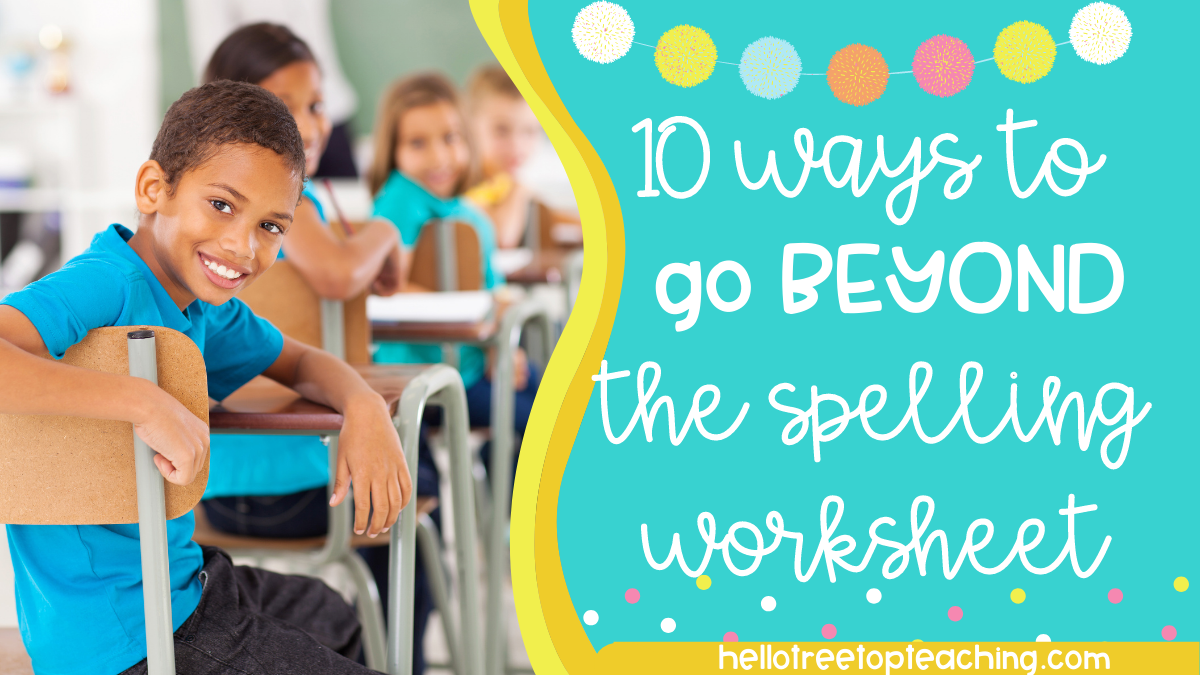The spelling worksheet, although it may have a place now and then, doesn’t engage students in a way that encourages and excites them to learn to spell correctly.
When I first started teaching, my spelling time was not very exciting for students. There were spelling lists and spelling practice and spelling tests, but there wasn’t any true engagement. And I found as I reviewed the words from previous weeks, students really didn’t remember how to spell. They were just memorizing them for the test. Yikes!😫
This started me on a journey to make my spelling time more enjoyable for my students in the hopes that that would help them to actually remember how to spell all the words. I knew that I really couldn’t change the spelling list or the fact that we had to take a spelling test, but I could change the ways that we practiced the words. I could just hand out a spelling worksheet, I had to engage them!
Below I have compiled my top 10 ways to make practicing spelling words a lot less like a spelling worksheet and a lot more like spelling games in the classroom.
Sorting Activities for Spelling
Sorting activities for spelling words are really easy and probably nothing new to you. You may be thinking of the typical, “Divide your paper into 3 columns and write the words in the column where they go”. But these are just a little bit different- they take less time and actually have the students laughing as they write.
Using Notecards
I start by having the students write each spelling word on the front of a note card and their initials on the back. Next I will tell the students to put any nouns on the left side of their desk and any verbs on the right side of their desk (read more about how I teach parts of speech with some freebies here). Then I tell them something that always shocks them.
“If this card is any other part of speech, throw it on the ground.”
This always has them squealing with excitement. Now when they go to sort these, they are desperately looking for one that they can throw on the ground. This is also why I have the students put their initials on the back of the cards. 😂
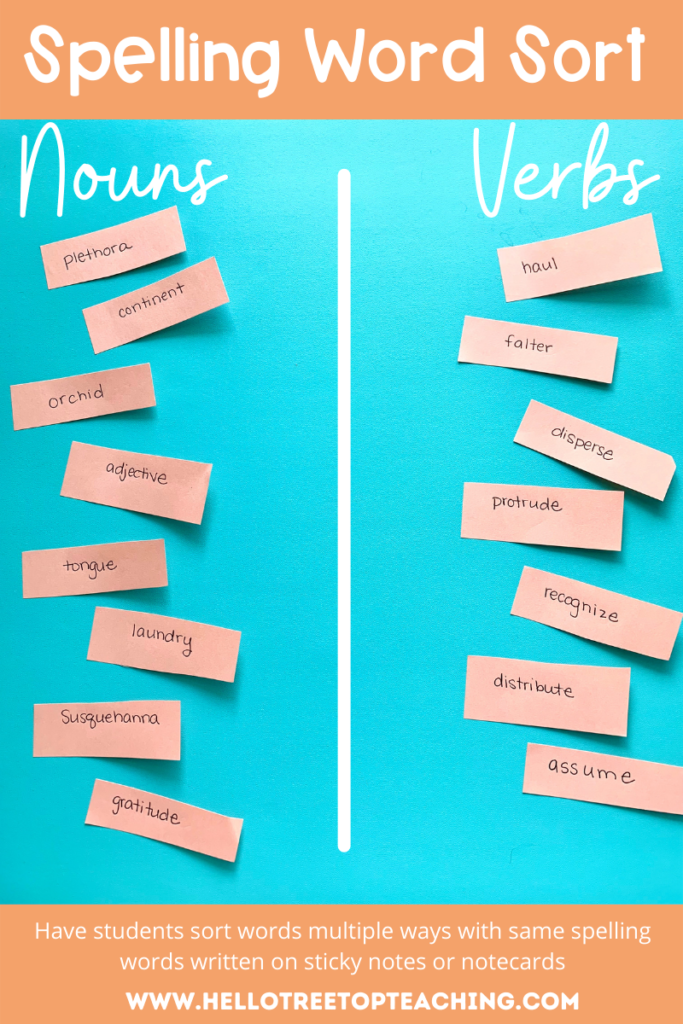
If I really want to up the engagement, I will set a timer for 1 to 2 minutes (depending on how many words in the list) and see which students can get all of the cards sorted in the right place within the time. With upper elementary students, if you make anything a competition- even an ordinary spelling worksheet, you immediately have their attention.
Here are some ways that you can have students sort using the note cards:
- Syllables
- Parts of speech
- Suffixes/Prefixes
- Spelling rule & rule breakers
- Number of vowels
The upside of this spelling word activity is that if the cards are already made, you can do several sorting activities throughout the week and a very short amount of time.
The downside of this is that the students aren’t actually writing the words multiple times and so it’s not always the best for practicing spelling the words. It’s really more of a connection piece to other grammar skills.
Silly Sort
Making my students laugh is probably one of the highlights of my job, and this spelling activity lends itself to that perfectly. I like to give students absolutely ridiculous categories and have them sort the words further. For this activity I will have them write the words into the columns to get that practice actually spelling the word. But because these categories are so ridiculous, there’s often giggles and excitement while they’re writing the words.
Here are some examples of ridiculous and silly categories I give the students:
- Useful while camping vs not useful
- Helpful to a superhero vs not helpful
- Words you may use while writing a note to your grandma vs not
- Words evil squirrels might use while plotting their takeover vs not
Of course they’re really going to have to use some out-of-the-box thinking for this, but it’s what makes it so fun. I do give my students a chance to pick a word and share why they put it in that category because a lot of times there is quite a bit of thinking that goes on behind that placement. Occasionally I will also tell them to pick 3 words to explain at the bottom of their page in sentences.
Charades with Spelling Words
If you made the cards for the sorting activity mentioned above, you can use them again to playa spelling game of charades. Place the cards face down and shuffle them. Then call a student to the front of the room and randomly hand them a card. Have the student act out the spelling word, and the rest of the class (or just their team if you want to add some competition) will guess. This activity is especially helpful when the spelling words are doubling as vocabulary words. To gear this game more towards spelling, you can have the students use slates/whiteboards and write down the word. The first student to guess the correct spelling word and spell it correctly would get a point.
Mad Libs
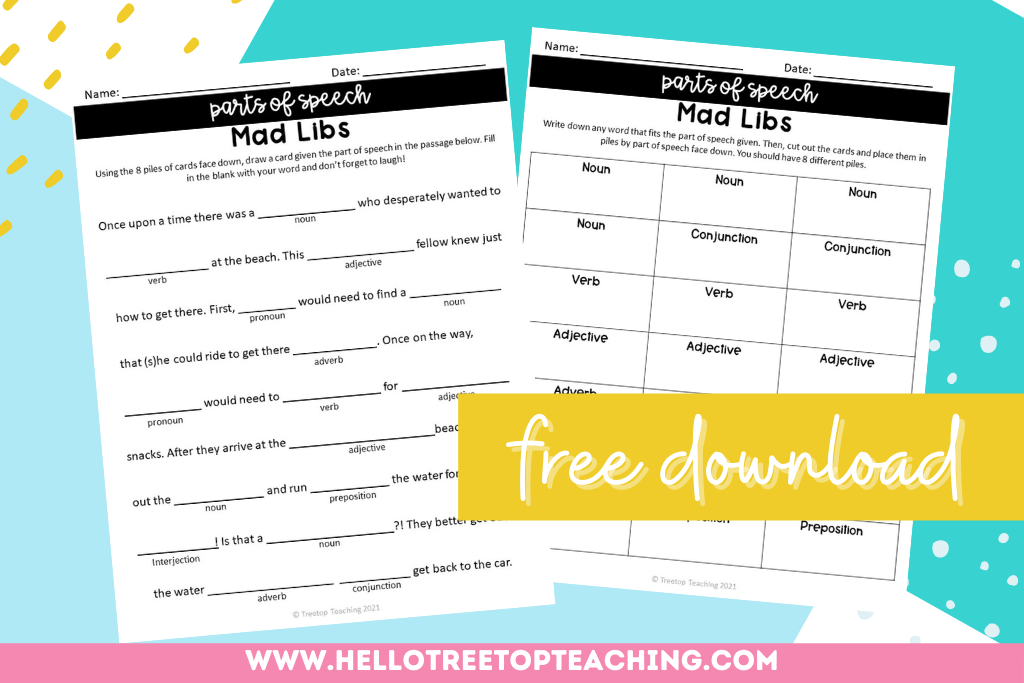
Another use for the spelling word cards would be to play Mad Libs. You can start this by having the students sort their spelling words by part of speech (read more about how I teach parts of speech with some freebies here). Then pull out a Mad Libs story and make sure the piles of cards are face down. Then start pulling cards from the pile as you reach certain blanks in the story. If you reach a blank that says noun, then the students would pull out a noun and write it in the story. If you reach a blank that says verb, then you would pull a verb card and write it in the story. You may need to add “ed” or “s” to certain words to make them fit more easily into the story. Be prepared for lots of laughs!
Want a free Mad Libs story and cards (along with a whole set of free parts of speech goodies!)?! Enter your name and email below and I will send it over now!
Spelling Word Search
This one may seem self-explanatory, but I have a twist that gets every 5th grader going. 😂 When I use the word search generator (I like this one) I make sure to type in all the spelling words spelled correctly first. Then I go back and type in some common misspelling of the spelling words. After I generate the word search and print a copy, I white out the misspelled words from the word bank. Now when the students go to find the spelling words in the word search, they really have to pay attention because common misspelling will also be hidden in the search.
Side note: this makes an awesome April Fool’s joke for upper elementary students as well. I will make a word search with the spelling words (which they’re used to), but this word search will have only common misspellings and no correct spelling words.
Round Robin Story Telling with Spelling Words
Round-robin story-telling is always a favorite of the spelling activities in my class. I often have to start by reminding the students what would and would not be school-appropriate for this activity. I usually start the activity by giving the first sentence. The sentence must include at least one spelling word from the list, and it must build on the sentences before it in order to tell a story. So if the spelling word was “assumed”, I could start the story by saying, “I had always assumed I would like 5th grade, but boy was I wrong.” Then we will go around the room or I will draw sticks to have them pop into the story with a sentence.
They do not have to go in a certain order of spelling words. They can just pick any word from the list. I write the spelling words up on the board and put a tick mark after each one is used. Obviously the further you get into the story, the less spelling words are available. It starts to get a little bit trickier, but that’s usually when the story turns out to be the best.
Sidewalk Chalk Spelling
This activity requires only sidewalk chalk and you get to take your class outside for some fresh air and spelling review. I have kids spread out on the blacktop and I start calling out spelling words. The students write their spelling words and then I prompt them to tell back the spelling orally in unison.
One of the most unexpected parts about this practice spelling activity is when the rest of the school comes outside for recess and sees our spelling words all over the black top. I often see little kids spelling the words out loud or trying to sound them out, and it just ends up involving a lot of the kids from the school.
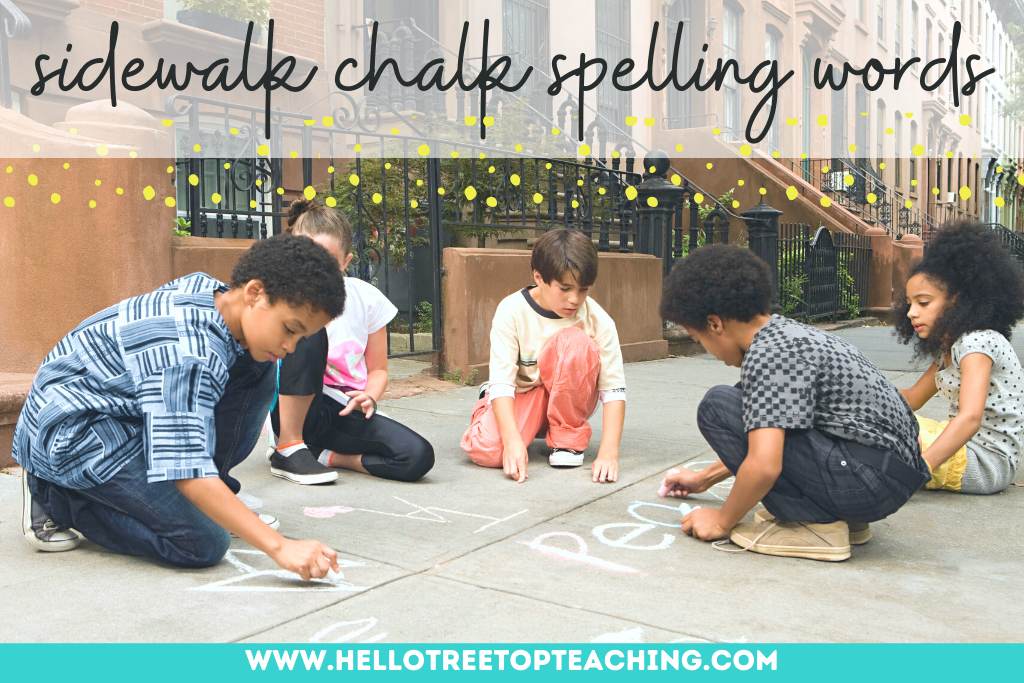
20 Questions
Here’s another way to go beyond the spelling worksheet- 20 Questions! You may need to alter this strategy because if you have only 15 spelling words then obviously they would be able to guess the spelling word in 20 Questions by simply asking, “Is it ____?” So you may decide to just make it 10 questions, or even more difficult- 5 questions.
I start by thinking of a word, and then the students are allowed to ask me yes or no questions only. The less questions that you give your students, the more creative they have to be with them. When I first do this activity I get a lot of, “Does the word start with an s?” But the students quickly learn that that usually only eliminates one or two words. Then they start to get creative and ask questions like, “Is this word a noun?” That question would obviously eliminate a lot more words from your spelling list (depending on the list of course).
You can also choose a student to pick a word and then answer the questions of their peers. I do, however, make sure the student shows me or tells me the word that they choose just to make sure that it’s fair.
Mystery Spelling Word Comics
This activity always gets kids excited because it involves drawing instead of writing. 😂I start by handing each student a 3 by 5 notecard and instructing them to cut it in half. Then I tell the student to pick 2 different spelling words to write one on the back of each card. Then on the front of the card they must draw a picture that would allow their classmates to guess that spelling word (without actually seeing that spelling word). I make the rule that there are no letters or numbers allowed in the picture which makes it that much more challenging.
Then once every student has finished their pictures, I will collect the notecards and sort them into piles by spelling word. I take a quick tally of how many of each word and then I start taping the pictures to a scrap white piece of paper. That afternoon I run to the copier and make a copy of the comics for each student. I usually give these mystery comics as morning work for the next day.
The idea now is that the students are looking at a “spelling worksheet” full of random pictures drawn by their peers and a checklist of how many of each spelling word is going to be used. Their job is to figure out which picture goes with which spelling word. They absolutely love it!
Password
This definitely goes beyond the spelling worksheet because it doesn’t involve any paper or pencils! I use this strategy not just for spelling but across all subject areas in my classroom. Each time the students come into the room in the morning, and sometimes when they come back from specials, there is a password to get in the room. The password is some question that has to do with the content that we’re studying. In this case it would be a spelling word. If the student that spells the word correctly, they get to come in the room. If they spell the word incorrectly, they have to go to the back of the line. Obviously I am not going to tell a student they can not come into the room.
You can use it with other subject areas, too. You could give them a multiplication fact, a science question, ask them to define a vocabulary word, or even just tell you their favorite color. I like that I can say, “Tomorrow’s password is going to be _____!”, and it just helps the students to pay a little bit more attention and really practice storing that information in their memory.
Spell, Draw, Write
This activity does involve a worksheet for spelling practice, but I think it fits the bill because it’s going beyond the spelling worksheet. For this activity the students will get a paper that has 3 columns. On the left they will write the word two times. I like to have my students write once in print and once in cursive. But you could create any guidelines for the way that the word will be written two times.

The middle section has a small box for the students to draw a picture that goes with the word. And all the way on the right is a box with lines in it where the students can write a sentence that uses that spelling word. Hence the name, “Spell, Draw, Write”
This activity is very independent for students and doesn’t require any facilitating or planning on the part of the teacher. It makes great morning work, center, or a spelling homework idea.
You can get this FREE download in my Teacher Pay Teacher’s store by clicking the link here.
Activities for Spelling Practice
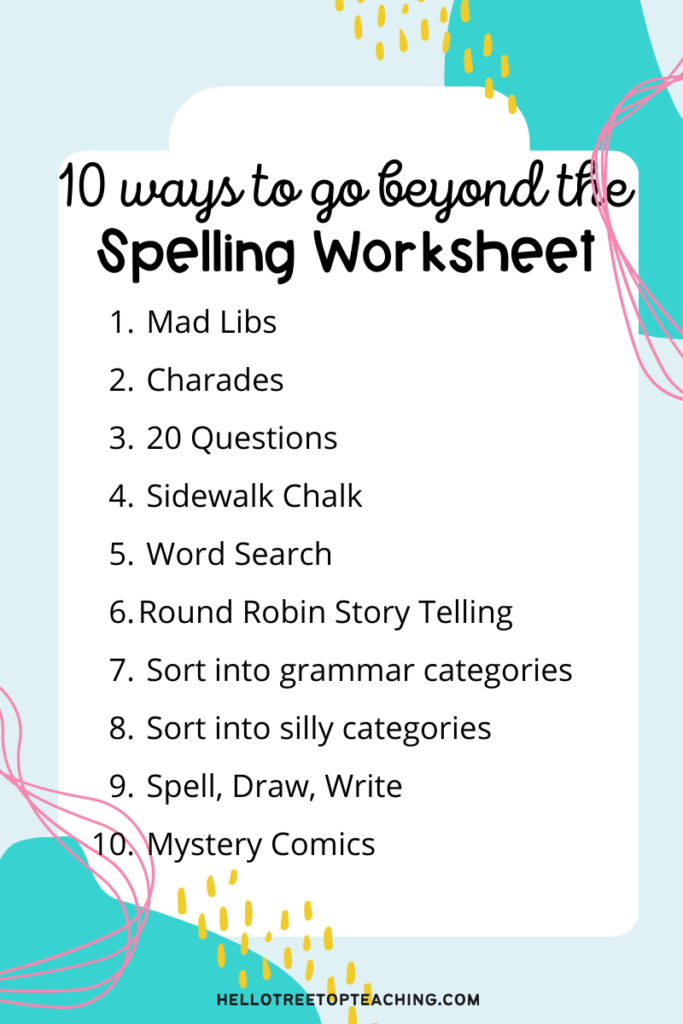
I think spelling gets a bad rap because it tends to be very repetitive with lots of spelling worksheets. But the truth is spelling doesn’t have to be boring for students or boring to teach. There are lots of ways to make spelling something that your students look forward to. They will begin to see it more as a game and a challenge to spell the words right rather than just drudgery. The goal of any of these activities would be to build excitement. Research shows that when students are excited not only does their engagement go up, but they are using more of their brain to remember and understand the concept at hand.
There is a time and place for the spelling worksheet, but there are also lots of other easy ways to make spelling come alive in your classroom.

